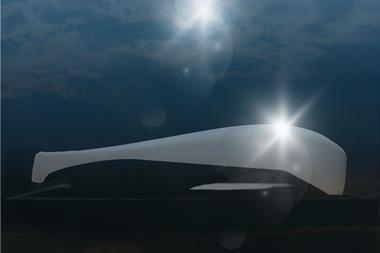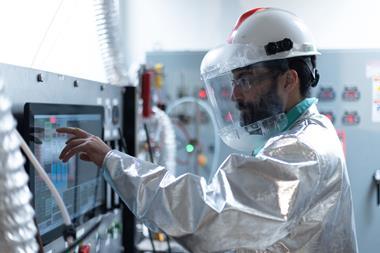
Malcolm Wheatley reports on how advanced production processes have enabled automotive glass to be augmented with added-value technologies
For the most part, glass alone does not provide the capabilities that a driver most values in a vehicle’s glass components. Instead, from road noise reduction to heat-reflective capabilities, and from built-in antennae and sensors to water-repellent glass, the real credit is due to a complex range of coatings, laminated plastic films, printing processes, and glass technology – all assembled together in a single transparent panel that has become an increasingly complex shape.
For automotive glass manufacturers, the challenge is to not only assemble the requisite technologies and production processes into a single panel in the first place, but to do so at volume, and in a manufacturing, design and commercial environment where driving cost out and production efficiencies up is paramount.
In contrast to the declining amount of steel used in each vehicle, automotive glass is joining the ranks of plastics, composites and other advanced materials in making up a growing proportion of the material makeup of a typical vehicle, and by a fairly significant amount.
Automotive glass manufacturer Pilkington – owned by Japan’s Nippon Sheet Glass since 2006 – points out that volume models such as the GM Astra, Ford Fiesta and VW Golf, through their various generations, now use around 20% more glass than they did 20 years ago. In brand-new vehicle designs, conceived from the ground up, the trend is even more noticeable, with vehicles such as the 2013 electricpowered supermini Renault Zoe featuring an extensive swept-back windscreen.
However, the proportion of the value of automotive glass represented by straightforward glass on its own has declined sharply. Instead, says industry expert Richard Gane, director of procurement consultants Vendigital, auto manufacturers’ procurement spend is increasingly going on added-value technologies – either to improve driving and vehicle performance, or to facilitate the subsequent vehicle assembly process.
“Simple, lower-spec aftermarket glass is one thing, and a full complement of technology competencies quite another,” he says. “Globally, the number of firms that can offer the full range is capabilities is very small.” Data from automotive glass manufacturer Pilkington tells the story. As a baseline, says the firm, back in 1980, ‘glass-asglass’ comprised virtually 100% of the value of the product. But by 2003, ‘glass-as-glass’ comprised around just half of the value, with the remainder coming from such things as the ability of automotive glass makers to engineer complex shapes, add encapsulation and extrusion capabilities to their manufacturing processes, and build into the basic screen technologies as solar control and de-misting. Ten years on, today ‘glass-as-glass’ is an even smaller piece of the pie, as automotive glass manufacturers pursue a twinpronged strategy of adding value.
 First, says Gane, they’re pushing the technology agenda, with ever more advanced innovations. Second, says Dave Kaufman, vice-president of OEM sales at American automotive glass manufacturer Guardian Glass, glass makers are increasingly taking over downstream processes that were formerly the province of vehicle manufacturers. “Ten years ago, we just made pieces of glass and shipped them to the plant,” he says. “Now, we ship them pre-primed, with mouldings, sensors and attachments – so that all the vehicle manufacturer has to do is fit the glass and apply sealants.”
First, says Gane, they’re pushing the technology agenda, with ever more advanced innovations. Second, says Dave Kaufman, vice-president of OEM sales at American automotive glass manufacturer Guardian Glass, glass makers are increasingly taking over downstream processes that were formerly the province of vehicle manufacturers. “Ten years ago, we just made pieces of glass and shipped them to the plant,” he says. “Now, we ship them pre-primed, with mouldings, sensors and attachments – so that all the vehicle manufacturer has to do is fit the glass and apply sealants.”
Nor are these various innovations especially recent. Saint- Gobain, one of the world’s top-four glassmakers, produced tempered safety glass as far back as 1927, and laminated safety glass just months later. By 1929, laminated safety glass was used in all new Ford vehicles – a major contribution to road safety at a time when half of all persons injured in auto accidents were hurt by broken glass.
What’s more, it isn’t solely glassmakers who are driving automotive glass innovation: automakers, too, have pioneered innovations. Quickclear (Instaclear in the US) is the trademark used by the Ford Motor Company for its electrically heated windshield technology. And curved windscreens arrived as far back as 1947, when Studebaker Motors designed the new Starlight Coupe with a curved windshield and back glass: prior to this, all automotive glass was flat. More recently, Volkswagen has developed a windscreen that’s resistant to fog, frost and ice, achieved by applying a thin layer of indium tin oxide to the outer layer of the glass.
The starting point in the production of the glass itself – which, around the world, is based on Pilkington’s patented ‘float glass’ process – is a batch of precisely mixed raw materials. Silica, sodium oxide, magnesia and lime are melted in a furnace and once molten, at approximately 1,000ºC, the mix is poured continuously from the furnace onto a shallow bath of molten tin, on which it floats. As it does so, it spreads out and forms a smooth, level surface – and one achieved without the grinding polishing processes that glass production formerly required.
After annealing via controlled cooling, the glass emerges as a polished product with virtually parallel surfaces. At which point, one of two safety-inspired toughening processes come into play.
Tempering is used for side and rear windows. Through a process of heating to very high temperatures – greater than 640°C – and differential cooling, internal stresses are created in the glass which cause it to shatter into very small blunt pieces if broken, thereby significantly reducing risk of injury. Laminating is mostly used for windscreens, although is increasingly being specified for side windows. The intention is prevent the ingress of glass fragments into the vehicle by bonding two pieces of glass together with a middle layer of polyvinylbutyral (PVB) plastic which prevents the sheet from shattering.
Initially opaque, the PVB layer only becomes transparent at the completion of the lamination process, which involves heating the glass layers to around 620°C, bending them into the required windscreen shape, cooling them, sandwiching the layer of PVB between them, and autoclaving at around 140°C under a pressure of 10 to 15kg/cm2.
At which point, clever tricks with the laminate inner and the surface coatings come into play. The tiered rows of black dots are printed on the inner laminate film. The black ‘surround’ blends the screen-exposed edge into the body. Coatings, too, deliver everything from scratch resistance to infrared and ultra-violet (UV) light reflection – with the latter capability, of course, not just boosting passenger comfort but also delivering i mproved fuel economy, via a lower load on the air conditioning system.
For automotive glassmakers, expertise in glass production alone is only part of the picture. The addition of coatings and electronic technologies are key elements to meeting the demands of OEMs and their customers.





































